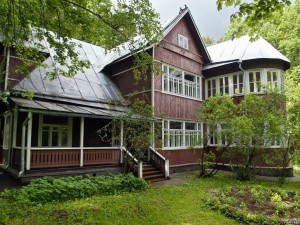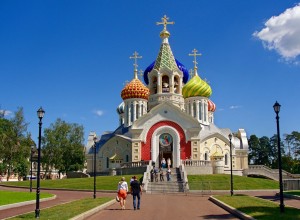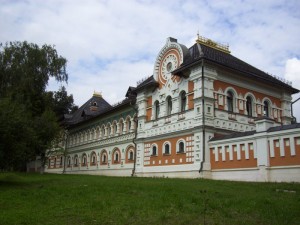Peredelkino Writers’ Village
In 1931 the Soviet writer Gorky returned from abroad to the Soviet State, to lead the  Writers Kolkhoz. There is a story that upon his return to the USSR, Stalin asked him about the living standards of foreign writers. Gorky replied that writers lived in big houses, close to nature and away from the noise and bustle of cities. When Stalin asked if Soviet writers had country houses; which translates as “dacha” into Russian, the answer was ‘no’. Soviet writers did not live in dachas. Stalin decided that this state of affairs was wrong and immediately asked for a list of 40-50 names, of the Soviet Union’s most outstanding writers of the time.
Writers Kolkhoz. There is a story that upon his return to the USSR, Stalin asked him about the living standards of foreign writers. Gorky replied that writers lived in big houses, close to nature and away from the noise and bustle of cities. When Stalin asked if Soviet writers had country houses; which translates as “dacha” into Russian, the answer was ‘no’. Soviet writers did not live in dachas. Stalin decided that this state of affairs was wrong and immediately asked for a list of 40-50 names, of the Soviet Union’s most outstanding writers of the time.
Gorky himself suggested the location of the writers’ village. One anecdote was he read that a wide, navigable river, the Setun, was near Peredelkino. It may have been so once, but in 1935 it looked more like a stream. In another anecdote, Gorky, previously suffering consumption, wanted to return to his place of solace and recuperation.
The new writers’ village was built in no time. Using a modified German design, the houses looked nice. However, as with things built too quickly, there were serious construction flaws. Designed for Germany’s milder winters, the design proved unfit for Russia.
looked nice. However, as with things built too quickly, there were serious construction flaws. Designed for Germany’s milder winters, the design proved unfit for Russia.
The first mention of Peredelkino in fiction was in the 1920’s, by Mikhail Bulgakov in his novel “Master and Margarita’. He called it Perelygino and located one of the novel’s characters there, the critic Berlioz.
Attention is often centered on Boris Pasternak dacha. He lived 10th February 1890 until 30th May 1960. The poet, novelist, translator and author of Dr. Zhivago died in Peredelkino village; and is buried with his family in the local church graveyard.
Many other interesting figures lived there, including the semi-dissident bard Bulat Okudzhava; and, for a time, Alexander Solzhenitsyn. There is a museum in the house formerly occupied by Kornei Chukovsky, the children’s writer and illustrator. Many other writers, artists, and musicians have lived in Peredelkino.
The arrest of author and playwright Isaak Babel, one of the most notorious events of Joseph Stalin’s Great Purge, took place in Peredelkino on May 15, 1939. Babel was then taken by automobile to the Lubyanka Prison, tortured, and shot by the NKVD.
The Summer Residence of the Patriarch of Moscow and All Russia is situated in Peredelkino. Alexy II, the last Patriarch, died there on December 5, 2008.
The excursion includes a visit to Boris Pasternak Museum, a walk around the area including the cemetery and Boris Pasternak’s grave, a lunch in Dom Tvorchesta (House of Creativity), a famous place where numerous literature professionals dined and worked.
